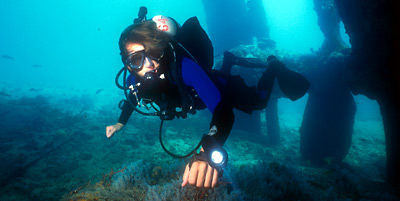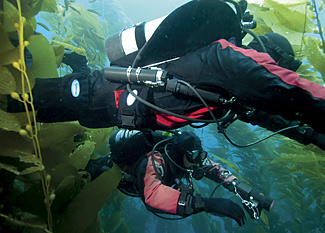Nobody ever saw a fish swim on an angle in the water, or an aeroplane fly at a 45 degree angle. The reason is obvious – flying or swimming like this makes us use more energy to move from one place to another.
As diver, we want to enjoy our time in the underwater world, so it makes sense to make our movement as easy as possible, so that we don’t get worn out or tired before time. Remember that the harder we work, the more we breathe as well, so a good streamlined diver is going to be able to spend more time diving than one that is always fighting against their body position and equipment. If we have a long swim to do it becomes even more important to be flat and efficient, so that we can achieve our goals.
The equipment we choose, and how we arrange it, has a big effect on our streamlining in the water. There are basically two ways of improving a divers streamlining. The first is to maintain a flat, horizontal, position in the water. The second is to think about how the equipment is placed on the body, and how it will add to our drag. We’re going to concentrate on the second aspect, equipment placement.
A horizontal divers head and shoulders will be breaking the water first, as they swim forward. Consequently, we want to place as much of the extra equipment that we can effectively in the area of water that is in the “shadow†of the head and shoulders. If we can “hide†the equipment there, then it won’t add much to the drag. Obviously, a cylinder can’t really go under your arm, so that has to go on the back of the diver. Let’s look at the rest of the equipment.

Buoyancy compensator
A backplate and wing type of BC has very little extra volume; the wing itself sits snugly next to the cylinder. There is no extra “clutter†in the chest area, and the harness straps are smooth to the body.
Lights
The canister type lights have a small light head, held in the hand. The battery packs can be quite bulky, so we place this on the waistband of the BC. It’s pushed back against the backplate, and it consequently sits under the arm, where it isn’t in the flow of water, and consequently doesn’t add to the drag.
The backup lights are clipped to the harness, and snug up under the arm as well, so you don’t even notice they’re there. Even though they’re small, if they dangle around off the body, they will contribute to the overall drag.
Hoses
Hose routing can add a surprising amount of drag to a diver. If you don’t believe it, fill a bathtub, and with a loop of low pressure hose in your hand, feel the amount of drag produced when you pull it through the water. So, what we do is to route the hoses such that they contribute as little as possible to the drag.
This starts by choosing a regulator that allows the hoses to be routed downwards, parallel and close to the cylinder. Next, we try to keep the hoses as short as possible (without compromising their utility). The high pressure hose needs to be around 56-61cm long, depending on the first stages and whether you’re using single or twin cylinders. The back-up regulator is frequently too long on many divers equipment, and it tends to extend over the right shoulder. It should come over the right shoulder, close to the neck while allowing full movement of the head when in use. A 56-61cm length hose, depending on the first stage and cylinder configuration, is usually about right.
Pockets
All of the rest of the equipment we use on a dive needs to be carried, so we need a place to store it all. An instructor of mine once asked me if I had any trousers without pockets in them. I thought I was being clever when I said that I did, so he then asked me if I ever wore them. To which the answer was, of course, no. Trousers without pockets are pretty much useless – you have nowhere to keep your stuff. OK, I hear the women now saying that that they have trousers without pockets, but you have handbags. And handbags don’t like getting wet!
So, our diving suit, be it dry or wet, needs to have pockets too keep or things in. These are best placed on the sides of the thigh. They need to be high enough so that we can get to the bottom of them without bending double. They go on the side to keep out of the flow and not act like water scoops when we swim, or drag if we’re close to the bottom.
I tend to keep all sorts of things in pockets – DSMBs, spools, wetnotes, line arrows, shears, spare double enders and anything else I might think I need on a dive. It doesn’t matter how full they are, it doesn’t add too the drag. Compare that with clipping everything to the harness – it would be very messy. Put some loops of bungee cord in the pockets, and clip everything to the loops. That way, if you can’t find something, you can empty the whole pocket, and select what you want, without risking losing anything.

Summary
Basically, try and keep all of your equipment as tidy as possible. Keep hoses short, and running down the length of the body as much as possible. Try to keep the chest area free. Try not to let equipment dangle down where it will catch on things. Use your pockets, and practice pulling things in and out of them. Remember that if something has to be carried, try and place it where it won’t add to the overall drag.
